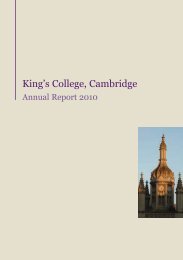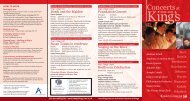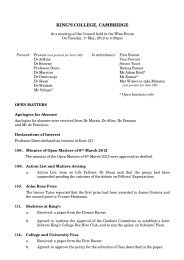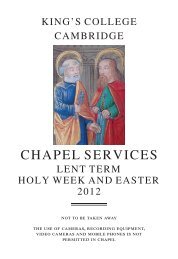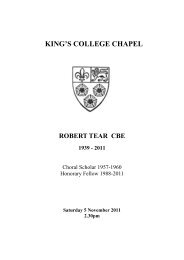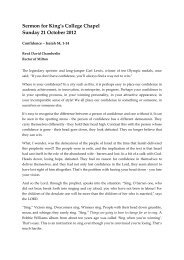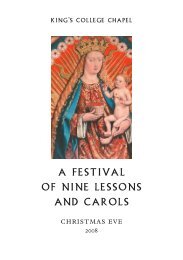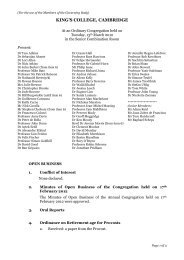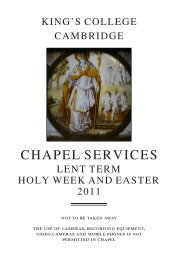Part 2 (Obituaries) - King's College - University of Cambridge
Part 2 (Obituaries) - King's College - University of Cambridge
Part 2 (Obituaries) - King's College - University of Cambridge
Create successful ePaper yourself
Turn your PDF publications into a flip-book with our unique Google optimized e-Paper software.
A National Research Council fellowship brought Ancel to Europe for two years<br />
and he had the good fortune to study Physiology under the Danish Nobel<br />
Laureate in Medicine, Pr<strong>of</strong>essor August Krogh, in Copenhagen. From<br />
Copenhagen Ancel moved on to <strong>Cambridge</strong> where he took his second<br />
doctorate, in Physiology, at King’s <strong>College</strong> in 1936. Although Ancel enjoyed<br />
his time in <strong>Cambridge</strong>, itchy feet meant another move after graduation, even<br />
though he was <strong>of</strong>fered a permanent position at <strong>Cambridge</strong> <strong>University</strong>.<br />
Harvard tempted Ancel with a position at their Fatigue Laboratory, and the<br />
funds to carry out large-scale research. He only stayed one year at Harvard,<br />
however, and most <strong>of</strong> that time he spent on an Andean mountaintop<br />
investigating the effects <strong>of</strong> altitude on himself and his colleagues. After<br />
Harvard he moved on to the <strong>University</strong> <strong>of</strong> Minnesota in 1937 where he was<br />
eventually to set up an entire Laboratory <strong>of</strong> Physiological Hygiene to research<br />
themes connected to the effects <strong>of</strong> diet and exercise on the human body. In<br />
1939 he married the biochemist Margaret Harvey with whom he remained<br />
for the rest <strong>of</strong> his life. Margaret died in 2006. He had married once before, at<br />
the age <strong>of</strong> 19, but this marriage had ended in divorce after only a few years.<br />
When war came Ancel developed the K ration (K as in Keys) for US soldiers<br />
and carried out the famous Minnesota Semi-Starvation Study on conscientious<br />
objectors to investigate the effects <strong>of</strong> malnutrition.This large study resulted in<br />
the influential two-volume work entitled The Biology <strong>of</strong> Human Starvation<br />
published in 1950.The experiment was more than a scholastic exercise, it was<br />
set up in anticipation <strong>of</strong> the large-scale relief efforts that were going to be<br />
necessary after the end <strong>of</strong> the war.<br />
When Ancel studied the data coming from actual starvation in war-torn<br />
Europe, he noticed the interesting fact that the death rate from coronary<br />
diseases decreased when food intake was reduced.This led him to study the<br />
relationship between diet and heart conditions on a group <strong>of</strong> businessmen<br />
from Minnesota and St Paul. From this study Ancel started suspecting that<br />
high blood cholesterol levels could be linked to the amount <strong>of</strong> fat in the<br />
diet. This suspicion was strengthened as Ancel carried out fieldwork in<br />
Europe and Japan, and by the findings <strong>of</strong> his wife Margaret, who studied the<br />
151<br />
OBITUARIES



